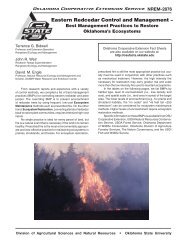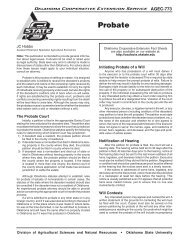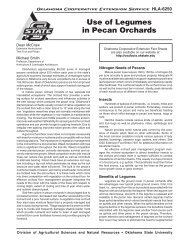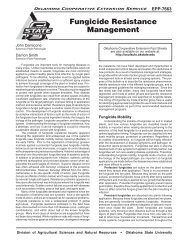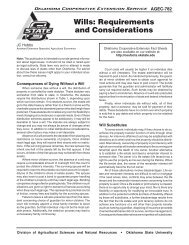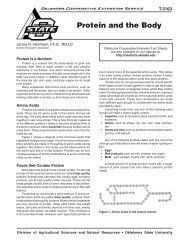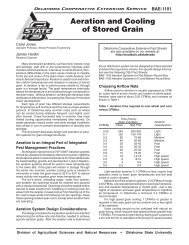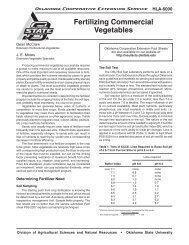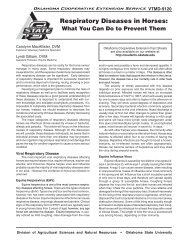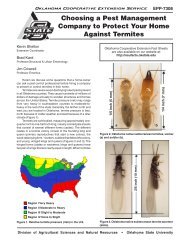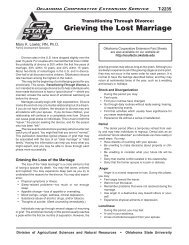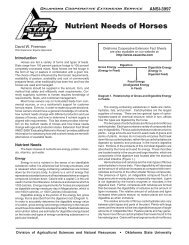Locating the Greenhouse - OSU Fact Sheets - Oklahoma State ...
Locating the Greenhouse - OSU Fact Sheets - Oklahoma State ...
Locating the Greenhouse - OSU Fact Sheets - Oklahoma State ...
You also want an ePaper? Increase the reach of your titles
YUMPU automatically turns print PDFs into web optimized ePapers that Google loves.
<strong>Oklahoma</strong> Cooperative Extension Service<br />
HLA-6701<br />
<strong>Locating</strong> <strong>the</strong> <strong>Greenhouse</strong><br />
Michael A. Schnelle<br />
Assistant Professor<br />
Extension Ornamentals/Floriculture Specialist<br />
John M. Dole<br />
Assistant Professor<br />
Floriculture<br />
Determining <strong>the</strong> site of a greenhouse operation involves<br />
numerous considerations before actual construction of <strong>the</strong><br />
facility. Although this fact sheet is intended to guide <strong>the</strong><br />
entrepreneur in selecting <strong>the</strong> site, it also can be used as a<br />
checklist when buying an existing operation. Before starting,<br />
it is important to have an idea of <strong>the</strong> type of plants you want<br />
to raise and sell and a decision as to whe<strong>the</strong>r you wish to be<br />
retail or wholesale. The following are major factors that should<br />
be investigated before greenhouse plans go beyond paper.<br />
Light<br />
Availability of sunlight is a major factor in deciding where<br />
to build <strong>the</strong> greenhouse. Do not base your decision on <strong>the</strong><br />
present season, but ra<strong>the</strong>r on <strong>the</strong> short days of winter. Plan<br />
to choose <strong>the</strong> area with maximum light availability. This will<br />
allow <strong>the</strong> grower to minimize or eliminate <strong>the</strong> use of artificial<br />
or supplemental light, depending upon <strong>the</strong> crops grown. Of<br />
course, shading may be necessary during a portion of <strong>the</strong><br />
growing season for heat and light reduction.<br />
Search for an area that is free of any potential shading<br />
from nearby structures or trees. A rule of thumb to follow is<br />
to avoid construction any nearer than 2.5 times <strong>the</strong> height of<br />
<strong>the</strong> nearby object. Removal of <strong>the</strong> shading object may be a<br />
more feasible alternative. This will apply to eastern, western,<br />
and sou<strong>the</strong>rn exposures.<br />
Place <strong>the</strong> greenhouse with <strong>the</strong> ridge in a north to south<br />
orientation to reduce interior shading from <strong>the</strong> structure itself<br />
on <strong>the</strong> plants.<br />
Land<br />
The site should be naturally level. This will decrease initial<br />
grading costs. If possible, <strong>the</strong> land should also be large enough<br />
to accommodate expansion without excessive grading.<br />
The ideal tract of land has a slight slope, up to five percent,<br />
which provides for proper air circulation and excess water runoff.<br />
If <strong>the</strong> soil has a high clay content, a greater slope may be<br />
needed. O<strong>the</strong>rwise, considerable expenses may be incurred<br />
to provide an elaborate drainage system. Determine if frost<br />
pockets exist in low lying areas and if flooding has occurred<br />
on <strong>the</strong> site. Low lying areas or valleys can sometimes exaggerate<br />
<strong>the</strong> effects of cold and hot air flow.<br />
<strong>Oklahoma</strong> Cooperative Extension <strong>Fact</strong> <strong>Sheets</strong><br />
are also available on our website at:<br />
http://osufacts.okstate.edu<br />
Soil is an important factor to consider. Ideally, a sandy or<br />
silt loam soil with high fertility and good drainage is recommended<br />
for container production. Soil is seldom used alone<br />
as a container media, but ra<strong>the</strong>r in a mix with soil-less amendments.<br />
In fact, many businesses grow plants with entirely<br />
soil-less mixes.<br />
Proper soil drainage is vital for growing plants in ground<br />
beds. Without proper drainage a number of problems will<br />
develop that may be insurmountable to <strong>the</strong> beginning grower.<br />
High salts and insufficient soil aeration are a couple of <strong>the</strong><br />
obstacles that may be encountered.<br />
A media pH ranging from 5.5 to 6.5 is acceptable for <strong>the</strong><br />
production of most greenhouse stock. The pH can be lowered<br />
by adding elemental sulfur or aluminum sulfate. However,<br />
raising <strong>the</strong> pH is more feasible and can be accomplished by<br />
adding dolomitic limestone. This is commonly used to correct<br />
soil-less mixes that are excessively acidic. Correct soil pH<br />
provides for maximum plant utilization of <strong>the</strong> soil’s nutrients.<br />
The Department of Agronomy at <strong>Oklahoma</strong> <strong>State</strong> University<br />
will test soil pH and nutrient status at a reasonable cost.<br />
Water<br />
Sufficient clean water is critical regardless of <strong>the</strong> crops<br />
to be grown. All water sources to be used in production must<br />
be tested with a solubridge to determine soluble salt content.<br />
Research indicates that container grown plants may be watered<br />
with nearly 1400 parts per million (ppm) of dissolved salts.<br />
However, seedlings and transplants normally tolerate water<br />
with salt concentrations of 200 ppm or less. When electrical<br />
conductivity is checked in micromhos per cubic centimeter<br />
(mho/cm), up to 200 mho/cm is tolerable by many species.<br />
Water pH must be known prior to irrigation of crops.<br />
Injection of phosphoric acid into <strong>the</strong> irrigation lines will help<br />
lower excessively high water pH. Acid type fertilizers can be<br />
used to help lower <strong>the</strong> pH in alkaline soils.<br />
Total soluble salts, pH, calcium, carbonate, magnesium,<br />
and sodium levels should be determined prior to growing<br />
greenhouse stock. The Department of Agronomy at <strong>Oklahoma</strong><br />
<strong>State</strong> University tests suitability of irrigation water at a nominal<br />
cost. Contact your local <strong>OSU</strong> County Extension Office for help<br />
in submitting a sample for testing.<br />
Division of Agricultural Sciences and Natural Resources • <strong>Oklahoma</strong> <strong>State</strong> University
Municipal water is generally acceptable but expensive in<br />
large production areas. Although chlorinated water is rarely<br />
harmful to plants, short of certain hydroponic systems, even<br />
0.5 ppm fluorine may reduce salability of sensitive crops.<br />
Softened water is not appropriate for irrigation purposes.<br />
Determine <strong>the</strong> pressure, pipe size, and flow rate of <strong>the</strong><br />
water source. When city water cannot be used or is not desirable,<br />
determine if a suitable well can be drilled. Also, look<br />
elsewhere for water sources such as streams, lakes, etc.<br />
Be certain that this water is a reliable source and will not be<br />
diverted any time in <strong>the</strong> future from your usage. Securing a<br />
water source can be accomplished by contacting <strong>the</strong> organization<br />
below:<br />
<strong>Oklahoma</strong> Water Resource Board<br />
Stream/Ground Water Division<br />
1000 N.E. 10th Street<br />
<strong>Oklahoma</strong> City, <strong>Oklahoma</strong> 73152<br />
(405) 271-2555<br />
An abundant source of water becomes particularly critical<br />
during <strong>the</strong> summer. A major time commitment in frequent<br />
watering will be necessary, often more than once a day in<br />
<strong>Oklahoma</strong>'s hot wea<strong>the</strong>r. Up to 1/3 gallon of water per square<br />
foot per day may be needed in potted plant production. Automated<br />
irrigation systems will be necessary in larger ranges to<br />
reduce excessive labor costs. During hot wea<strong>the</strong>r, greenhouse<br />
plants may perish or be severely injured if even one irrigation<br />
is missed. Ideally, a backup system for irrigation should be<br />
planned. The water supply needed to cool <strong>the</strong> greenhouse<br />
in <strong>the</strong> summer must also be considered.<br />
Air<br />
Air pollutants such as sulfur dioxide, fluorides, and ozone<br />
have been shown to be detrimental to plant growth. Site selection<br />
around industrial areas and areas of high vehicle passage<br />
could be a problem. However, in most areas of <strong>Oklahoma</strong>,<br />
air quality is not a limiting factor in plant growth.<br />
Utilities<br />
Electricity<br />
It is wise to anticipate electrical needs for <strong>the</strong> future and<br />
provide sufficient capacity for full electric utilization. Currently,<br />
electricity is not competitive with natural gas in <strong>Oklahoma</strong> and<br />
is <strong>the</strong>refore not feasible as a heating source. However, check<br />
with <strong>the</strong> local electric company to get a commercial rate and<br />
determine if <strong>the</strong>re are declining block rates for exceeding a<br />
particular energy amount in a given time period. Electricity<br />
will be needed at <strong>the</strong> very least for ventilation purposes at 4<br />
to 6 kilowatts for a 1/4 acre range.<br />
Natural Gas<br />
Natural gas is clean and relatively inexpensive. Also, gas<br />
heating systems are generally less expensive to purchase. The<br />
cost of <strong>the</strong> energy source will be a major factor in determining<br />
<strong>the</strong> location and size of <strong>the</strong>se structures. New growers can<br />
reduce heating costs by choosing crops which can be grown<br />
during warm times of <strong>the</strong> year and by avoiding crops with high<br />
temperature requirements.<br />
Auxiliary Power/Alarm System<br />
An emergency energy source is important to consider<br />
for a commercial operation for electrical support of heating<br />
and ventilation equipment. In addition, an alarm system is<br />
imperative to warn <strong>the</strong> operator/caretaker of impending freeze<br />
damage. Many tender plants grown in <strong>Oklahoma</strong> greenhouses<br />
are damaged by temperatures well above freezing.<br />
Transportation and Parking<br />
<strong>Locating</strong> <strong>the</strong> greenhouse near a major road will help<br />
facilitate <strong>the</strong> movement of plants to and from <strong>the</strong> site. In planning<br />
a retail operation, include ample parking for customers<br />
and employees. Provide 18 feet for head-in parking spaces<br />
and 30 feet clearance for back-out and turning. Any curves<br />
or turns should have an 18 to 20 foot inside radius. Check for<br />
local ordinances which dictate regulations on exits, entrances,<br />
and minimum car stall space. Plan for <strong>the</strong> greatest exposure<br />
possible when retailing to <strong>the</strong> public.<br />
Wholesale greenhouses must consider access for <strong>the</strong>ir<br />
buyers. Major roadways are desirable for truck and postal<br />
arrangements and close proximity to a major airport may be<br />
desirable.<br />
Labor<br />
Be certain that an adequate labor pool is available for<br />
your operation. Operating a greenhouse range in a remote<br />
area, even for a wholesale operation, may not be <strong>the</strong> ideal<br />
situation. Consider times of peak labor needs such as during<br />
<strong>the</strong> spring and before holidays.<br />
<strong>Greenhouse</strong> Expansion<br />
A common oversight in greenhouse construction plans<br />
is <strong>the</strong> possibility of future expansion. By planning for a larger<br />
operation in years to come, <strong>the</strong> need for relocation may be<br />
avoided. Most greenhouse ranges will double in size within<br />
a few years and even greater expansion should be anticipated.<br />
<strong>Greenhouse</strong> Layout and Design<br />
Below is one example for designing <strong>the</strong> greenhouse and<br />
associated areas (Figure 1).<br />
Additional Reading<br />
Mastalerz, John W. The <strong>Greenhouse</strong> Environment. John<br />
Wiley and Sons, 1977.<br />
Nelson, Kennard S. <strong>Greenhouse</strong> Management for Flower and<br />
Plant Production. The Interstate Printers and Publishers,<br />
Inc., Danville, Illinois, 1980.<br />
Nelson, Paul V. <strong>Greenhouse</strong> Operation and Management.<br />
Reston Publishing Company, Inc., 3rd ed., 1985.<br />
6701-2
Figure 1. An example for designing <strong>the</strong> greenhouse and associated areas. Typically, greenhouses are on a level, but well<br />
drained, sou<strong>the</strong>rly exposed site.<br />
Industry Trade Magazines<br />
GrowerTalks<br />
P.O. Box 532<br />
1 North River Lane<br />
Suite 206<br />
Geneva, IL 60134<br />
<strong>Greenhouse</strong> Grower<br />
37733 Euclid Avenue<br />
Willouby, Ohio 44094<br />
Organizations<br />
OK <strong>Greenhouse</strong> Growers Association<br />
400 N. Portland<br />
<strong>Oklahoma</strong> City, OK 73107<br />
Professional Plant Growers Association<br />
Box 27517<br />
Lansing, Michigan 48909<br />
<strong>Greenhouse</strong> Manager<br />
Branch-Smith Publishing<br />
120 St. Louis Avenue<br />
Fort Worth, TX 76104<br />
6701-3
The <strong>Oklahoma</strong> Cooperative Extension Service<br />
Bringing <strong>the</strong> University to You!<br />
The Cooperative Extension Service is <strong>the</strong> largest,<br />
most successful informal educational organization<br />
in <strong>the</strong> world. It is a nationwide system funded and<br />
guided by a partnership of federal, state, and local<br />
governments that delivers information to help people<br />
help <strong>the</strong>mselves through <strong>the</strong> land-grant university<br />
system.<br />
Extension carries out programs in <strong>the</strong> broad categories<br />
of agriculture, natural resources and environment;<br />
family and consumer sciences; 4-H and o<strong>the</strong>r youth;<br />
and community resource development. Extension<br />
staff members live and work among <strong>the</strong> people <strong>the</strong>y<br />
serve to help stimulate and educate Americans to<br />
plan ahead and cope with <strong>the</strong>ir problems.<br />
Some characteristics of <strong>the</strong> Cooperative Extension<br />
system are:<br />
• The federal, state, and local governments cooperatively<br />
share in its financial support and<br />
program direction.<br />
• It is administered by <strong>the</strong> land-grant university as<br />
designated by <strong>the</strong> state legislature through an<br />
Extension director.<br />
• Extension programs are nonpolitical, objective,<br />
and research-based information.<br />
• It provides practical, problem-oriented education<br />
for people of all ages. It is designated to take <strong>the</strong><br />
knowledge of <strong>the</strong> university to those persons<br />
who do not or cannot participate in <strong>the</strong> formal<br />
classroom instruction of <strong>the</strong> university.<br />
• It utilizes research from university, government,<br />
and o<strong>the</strong>r sources to help people make <strong>the</strong>ir own<br />
decisions.<br />
• More than a million volunteers help multiply <strong>the</strong><br />
impact of <strong>the</strong> Extension professional staff.<br />
• It dispenses no funds to <strong>the</strong> public.<br />
• It is not a regulatory agency, but it does inform<br />
people of regulations and of <strong>the</strong>ir options in meeting<br />
<strong>the</strong>m.<br />
• Local programs are developed and carried out in<br />
full recognition of national problems and goals.<br />
• The Extension staff educates people through<br />
personal contacts, meetings, demonstrations,<br />
and <strong>the</strong> mass media.<br />
• Extension has <strong>the</strong> built-in flexibility to adjust its<br />
programs and subject matter to meet new needs.<br />
Activities shift from year to year as citizen groups<br />
and Extension workers close to <strong>the</strong> problems<br />
advise changes.<br />
<strong>Oklahoma</strong> <strong>State</strong> University, in compliance with Title VI and VII of <strong>the</strong> Civil Rights Act of 1964, Executive Order 11246 as amended, Title IX of <strong>the</strong> Education Amendments of 1972, Americans<br />
with Disabilities Act of 1990, and o<strong>the</strong>r federal laws and regulations, does not discriminate on <strong>the</strong> basis of race, color, national origin, gender, age, religion, disability, or status as a veteran in<br />
any of its policies, practices, or procedures. This includes but is not limited to admissions, employment, financial aid, and educational services.<br />
Issued in fur<strong>the</strong>rance of Cooperative Extension work, acts of May 8 and June 30, 1914, in cooperation with <strong>the</strong> U.S. Department of Agriculture, Robert E. Whitson, Director of Cooperative Extension<br />
Service, <strong>Oklahoma</strong> <strong>State</strong> University, Stillwater, <strong>Oklahoma</strong>. This publication is printed and issued by <strong>Oklahoma</strong> <strong>State</strong> University as authorized by <strong>the</strong> Vice President, Dean, and Director<br />
of <strong>the</strong> Division of Agricultural Sciences and Natural Resources and has been prepared and distributed at a cost of 20 cents per copy. 0503<br />
6701-4



